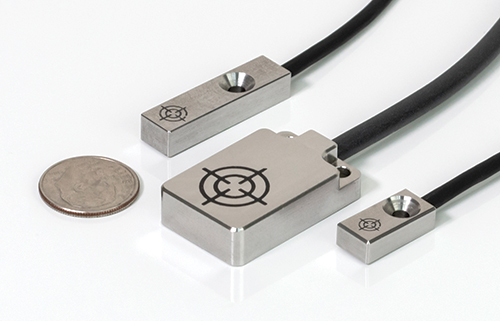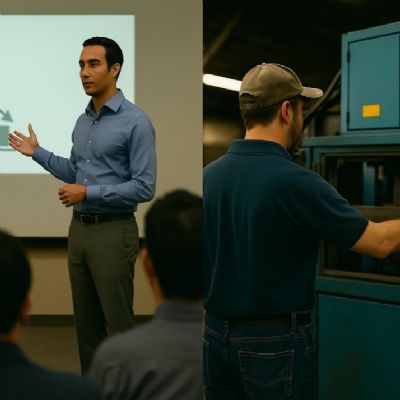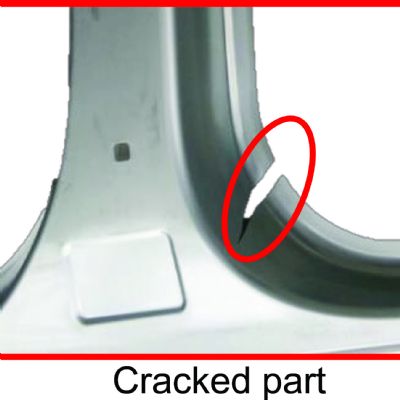Selecting Sensors
April 25, 2019Comments
An industry expert shares some do's and don'ts when it comes to sensors.
The next generation of sensing technology takes metal forming well beyond the capabilities of, say, proximity sensors. Just how far remains to be seen. However, with the transformation underway, now is the time for companies to familiarize themselves with new offerings and their capabilities. In this Q&A, Marcel Ulrich, sensor product manager at Twinsburg, OH-based Pepperl + Fuchs North America, shares his insights.

The miniaturization of durable metal-face inductive sensors improves die protection, increasing uptime.
MetalForming: What makes in-die sensing advancements so important?
Ulrich: The cost of a modest die crash can be as much as $10,000. Typically it’s more. Preventing those occurrences is a high priority. While the potential for damage and downtime is great, the solution is usually very economical. Often it’s an $80 sensor. And damage and downtime aren’t the only costs involved. As one of our customers put it: “If there’s an $80 sensor that prevents me from booking a same-day flight to our Mexico facility to investigate a crash, I’m buying it.”
MetalForming: Sounds simple. Are there common mistakes for stampers to avoid?
Ulrich: Selecting the wrong sensor for the wrong application. A common example: overuse of laser-based optical sensors when LED-based models will work fine. LED-based sensors have come a long way. They now offer comparable sensing ranges, which equates to optical power to their laser counterparts, and at a lower cost. While laser beams offer the tightest focal point, infrared and visible red LEDs also offer a very precise beam.
Another common mistake: opting for too small of an inductive sensor with insufficient range. This can happen when not accounting for the requirement to recess the sensor to protect it from mechanical impact. We’re really not seeing many installation issues today as we did maybe 10 yr. ago. The reason: Today’s metal formers are sensor savvy.
MetalForming: Can you offer some tips for selecting the right sensors?
Ulrich: For optical sensors, one recommendation: Choose infrared when oil and lubricants are present. Infrared tends to ignore oil mist, while visible red beams can detect it, and it’s best for darker colors. Also, remember that the manufacturer’s datasheet sensing range calibrates to a reference object of a specific dimension and material. For example, when inductive prox (proximity sensor) targets the thin sheet edge, the sensor must be much closer than if it were detecting the flat sheet surface. Likewise, a diffuse mode photoeye with a 2-mm light spot won’t see a 1-mm target at its full data-sheet range. The smaller target reflects insufficient light.
MetalForming: What trends should stampers be aware of?
Ulrich: Lightweighting of vehicles continues to drive increased use of inductive sensors for nonferrous applications. While traditional inductive sensors detect aluminum at a reduced range, reduction Factor 1 models, which detect all metals identically, and nonferrous-selective types provide full range to aluminum targets. Meanwhile, another trend, the movement away from long cylindrical sensors to smaller flat pack styles, provides similar sensing ranges while consuming considerably less real estate within the die or tooling.
MetalForming: What are some of the latest sensor developments that you find most exciting?
Ulrich: Double blank detection always has been tricky. Now there are affordable camera-based sensor systems that detect double blanks at distances up to 1 ft. even with sheet thicknesses under 1 mm, even while the target vibrates or wobbles. Such systems find use not only for blanks, but for stamped, double-stacked brackets and parts as well.
Also of significance: the miniaturization of metal-face sensors. A fantasy only a few years ago, internet-compatible wristwatches are now commonplace. As electronic components continue to shrink, so do sensors. A direct result of this technology advancement: increasingly smaller metal-face inductive designs. The smaller the sensor, the closer it must be to the target material, and the more likely it will experience abrasion and impacts, making durability an important characteristic for miniature sensors.
MetalForming: With new technology often comes challenges. Is the same true of sensors?
Ulrich: Similar to when proximity sensors first began appearing in dies roughly 20 years ago, today’s maintenance personnel and engineers need to familiarize themselves with the next generation of sensing technology. Adaptations always are slow, as no one wants to be the first to embrace an unknown. One such unknown is IO-Link—a gateway to unlocking sensor IIoT (Industrial Internet of Things) possibilities on the shop floor. While traditional sensors tell if a product is present or absent, IO-Link models do that and more. Sensing windows can be preset to identify if a part is in-place, too close, or too far away. They can provide other data, such as the temperature at the sensing point. Replacement sensors with customized parameter settings are instantly cloned upon plug-in, so there’s no need for recalibration. It should be noted that a traditional sensor PLC can’t access this higher-level information. An IO-Link controller or input card is required.
While it sounds like a great idea to have usage data and temperature feedback for the sensors within a die, it also can be information overload. It will be interesting to see what sensor diagnostic information metal formers truly need down the road, and what is superfluous.MetalForming: What about ROI and payback?
Ulrich: Efficiency improves when you eliminate the time spent replacing sensors because you can focus on bigger issues. When it comes to inductive sensors, designed to detect objects without physical contact, with proper installation and process control, the sensor should never experience damage. However, here’s the reality: positional tolerances sometimes make sensor-target impacts inevitable. In such instances, inductive sensors with stainless steel sensing faces dramatically outlast their plastic-face counterparts. While they cost roughly 25 percent more than traditional sensors, their life expectancy, as much as 20 times longer, makes up for that. We tell our customers to place them in their worst-case applications. MF
View Glossary of Metalforming Terms
See also: Pepperl+Fuchs, Inc.
Technologies: Sensing/Electronics/IOT
Comments
Must be logged in to post a comment. Sign in or Create an Account
There are no comments posted. Sensing/Electronics/IOT
Sensing/Electronics/IOTEliminating Pressroom Waste—One Walk at a Time
Manuel Resendes June 10, 2025
Prime Controls’ DS-Flex—a Configurable, Versatile Double-She...
December 30, 2024








